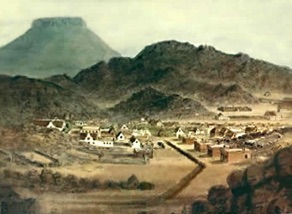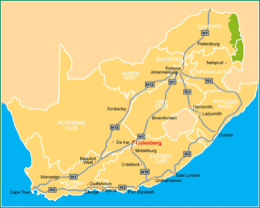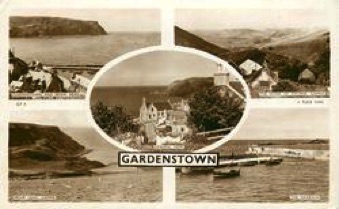James Rait
James Rait seems to have emigrated to South Africa some time before 1851 for reasons unknown (why there and not say America, Canada or Australia one wonders). His death notice states that he was born in Gamrie, Banffshire, Scotland and that he was 34 years, 10 months and 10 days old when he died (cause of death not given) on 20 October 1857 at the house of Mr Thomas Bradfield, Hopefield, District of Queens Town, Eastern Cape. His parents were given as James Rait and Jane Rait and he was a teacher to Government at Colesberg, Northern Cape. He was married to Juliana Rait (see below). The couple had two children: William - minor; and Walter Scott, also a minor, who apparently died one week after his father. James left both moveable and immovable property of the value of about £800.
The only James Rait to be found born in Gamrie is the one born on 19 December 1823 and christened on 17 July 1824. Interestingly, and unusually, only the mother’s name is given - Jean Rait (which ties in with the death notice). This is clearly her maiden name - the Old Parish Register notes her abode was Gardenstown, Gamrie and that James was her natural son. No father is given, but there are the words (Patre incerto) added. This means “father uncertain” - and whether unknown or not it is somewhat more charitable than the stark “illegitimate”. Witnesses (to the baptism) were Wm Rait, Gardenstone and the Revd. Jas Tough, Manse of Gamrie. I presume that William Rait was Jean’s father.
James is to be found in the 1841 census living at Findon, Gamrie, aged 16, born Banffshire in the household of John Alexander. Occupations were not given in 1841 but in the 1851 census John Alexander is a mill wright and farmer of 30 acres - thus in 1841 James was most likely a farm labourer on his farm. James does not seem to be in the 1851 census (presumably having gone to South Africa). His mother Jane seems not to be present in either 1841 or 1851. However, it looks like she married, for a death (of kidney disease) of a Jean Laird is recorded for 18 March 1866 in Gardenstown, Gamrie. She was aged 72 (thus making her born in 1794) and the widow of George Laird, Innkeeper. In the death extract her father is given as William Rait, shoemaker, deceased and her mother was Elizabeth Rait, Mrs Massie (also deceased). Jane married George Laird, a mason, on 2 November 1835 in Gamrie - both were from Gardenstown. In the 1841 census for Gardenstown, Gamrie there is George Laird, 50, born 1791 in Banffshire, and Jean Laird, 40, thus born 1801 in Banffshire. In the 1851 census for 47, Gardenstown, Gamrie, we have Jean Laird, widow, 53, inn keeper, thus born 1798 in Banffshire. And in 1861 living in Main Street, Gamrie there is Jean Laird, 65, spirit dealer, thus born 1796 in Gamrie. If her father’s occupation was a shoemaker, then this might indicate that he was actually William Rait Senior (see below) - though he would have been aged about 50 when he had Jean.
In the 1841 census residing in Gardenstown, Gamrie, Banffshire we find William Rait, age 64 (born 1777 in Scotland). This is probably him. In the 1851 census, there is a William Raith, aged 76, unmarried, general merchant, born Banffshire living at 63, Gardenstown, Gamrie in 1851. This might be him even though the record states he is unmarried and Jean’s mother is named in her death extract, but, of course, they may not have been married. (Coincidentally, in 1851 there is a William Rait, aged 74, farm labourer, residing at Woodside, Colliston, (parish of St Vigeans, Angus) born in Kirkden, Angus - despite the right age, this is probably not the same chap, though agricultural labourers did move around - and there are many Raitts in the various farms of Colliston.) He presumably died before 1861 as he does not seem to be in that census. However, in fact we do find two William Raits dying in Gardenstown - one on 25 May 1835, aged 91 (thus born about 1744), and a note says Senr. (i.e. Senior); and the other, likely his son, who died in Gardenstown on 28 September 1852 aged 73 (thus born about 1779). This will be the William in the 1841 census. There seems to be only one William Rait who married in Banffshire and that is the one with abode Aberdeen, who married Sophia Hay, of Keith, on 18 August 1766 in Keith. In fact, though, they were also married at St Nicolas, Aberdeen - and had several children (though apparently not a William) between 1767-1782 - all baptized in St Nicholas. So this could well be the William Rait Snr above. A William Rait was baptized in Fintray, Aberdeenshire on 19 June 1740 with his father named as James Rait. If this is the same William who went to Gamrie, then he would have been 95 when he died not 91! On 22 November 1787 William Rait, shoemaker in Gardenstown, was recorded as the father of Andrew Rait (no mother given). This is presumably the older William Rait. On 15 June 1834 William Rait, merchant, and Jane Webster, had a daughter named Margaret in Gardenstown. And this is almost certainly the younger William Rait.
James’s wife, Juliana, was born Julia Anna Nelson about 1830 in Uitenhage, Eastern Cape to John Nelson (actually her father seems to have been George - John was the name of her brother) and Mary Turvey (born in Dublin, Ireland). She died on 26 March 1904 on the farm Palmietfontein aged 75. She was a widow and a retired teacher and the name and approximate death of her spouse was given as James Rait, died October 1858. The names of the children (deceased, major or minor) were given as William James Rait (major), and Henry Alfred Rait (deceased). One wonders why the child Walter Scott Rait, noted in James’s death notice, is not mentioned here, and why Henry Alfred appears - but not in James’s record. Perhaps Juliana was pregnant with him at the time of her husband’s death. Juliana left no will and no property. The death notice was signed by W. J. Rait, son of the deceased, in Dordrecht, Cape Province.
A little further research reveals that a son, Edward Norton Rait, of William James and Ida Rait, of Eldoret, Kenya Colony, died on active service in Kenya on 1 August 1916 aged 22. Edward was born at Dordrecht, Cape Province and was a Trooper with the East African Mounted Rifles, ‘A’ Squadron. He is buried in Kajiado Cemetery, Kenya. It would appear that William James was born about 1858 and his wife Ida Bradfield was born on 5 July 1859 in Cape Colony. Her father, Daniel, was a brother of the John Bradfield mentioned above. They appear to have had five children: three girls and two boys - the other son being named Harry and born about 1893. Their daughter Julia died aged 17.
But then I came across an article (with copious references) written by Dr Helen Ludlow of the University of Witwatersrand in 2012 and entitled “The government teacher as mediator of a “superior” education in Colesberg, 1849-1858” - and who should it be about, but none other than James Rait! The abstract states “This article is set in the socially fluid context of a northern frontier town in the nineteenth-century Cape Colony. It examines the identity of James Rait, the young teacher at Colesberg Government School from 1849-1858. Rait was charged with implementing the complex curriculum of the New System of state education which had been introduced to the colony in 1839. Both the curriculum and textbooks were strongly rooted in Scottish educational discourses and this article investigates the teacher as mediator of a particular construction of knowledge and dispositions. It reflects on this role as the teacher who taught over 100 children of diverse cultural, class and racial backgrounds. It also examines the teacher's attempts to manage his growing incapacity to sustain a respectable manly identity. This was because of the incommensurate demands of his career and family on his ailing body and limited income. Disease can be seen to feminise the body; and while illness increasingly removed Rait from his classroom, his wife and particularly his female assistant were to bridge the domestic and working worlds and make up for his deficiency.”
From the article we learn that, as surmized, James clearly had gone to South Africa between 1841 and 1851. “In May 1849, the Scottish-born assistant teacher at the Stellenbosch Government School, James Rait, was promoted to the remote Karoo village of Colesberg. To be a government teacher at the Cape Colony in the mid-nineteenth century was to assume a position associated with high status and respectability within the colonial order.” The article continues “As Rait's illness advanced, he was granted permission to employ one of his senior pupils, Eliza Arnot, as a paid pupil-teacher. What makes her role significant is that she is one of very few young women to be given a formal, if junior, position within state education. In addition, the racial mix of her family was notable.” What the illness was, we don’t know. However, Eliza Arnot was almost certainly Eliza Sophia Arnot who was the daughter of the mother Mary Nelson (neé Turvey) of James’s wife Juliana from her second marriage to David Arnot whom she married on 13 March 1833. Eliza married someone called Bradfield. In fact towards the end of the article we learn that his name was John Bradfield, the son of an 1820 Settler. This is probably the son of Thomas Bradfield, at whose house James died - and the brother of Juliana. David Arnot signed off on James’s death notice.
Ludlow’s article goes on to explain the New System of schooling which was introduced in an attempt to improve the quality of Cape education. The efficacy of the system would hinge on having talented, knowledgeable teachers of sound Christian characterwho would be rewarded financially and through promotion for seeking their own improvement. This good teacher was eventually epitomized by the graduate of a Scottish university with a classical or mathematical degree. A high level of academic proficiency for such teachers was sought and first-class government teachers had to pass a rigorous examination. Despite his initial work as an agricultural labourer, James Rait obviously studied assiduously along the way (in Scotland? or South Africa, for instance, in Stellenbosch?) and was able to meet the exacting criteria to be promoted in 1849 to government teacher in Colesberg - an arid frontier town, 800 km from Cape Town and 450 km from Port Elizabeth. The article gives a vivid and fascinating description of Colesberg and the schooling there - but it is really the snippets about James Rait that I want to pick out. (The family of David Arnot is also mentioned in the article - his father had been a blacksmith back in Scotland. There is also a lengthy passage on Eliza Arnot as pupil-teacher and her role in assisting James).
James was a 26 year old bachelor when he became the third teacher to take up the first-class government in Colesberg in 1849 and he appeared to have a sense of vocation. The population of the town was split roughly equally between whites and coloured, though it is not clear how many of the latter attended the school. However, from early on, James Rait’s classroom was filled to capacity with children seemingly of all ages, genders and races. For most of his career in Colesberg, James conducted his school on his own, with the periodic assistance of a senior pupil acting as a pupil-teacher. However, it was only as his illness became critical by 1856, that he acquired the formal services of (16 year-old) Eliza Arnot as a paid pupil-teacher. After a discourse on the subjects and topics taught at school, the article mentions James again. “In common with his colleagues elsewhere, James took up the theme of sustained respectability requiring a better income. His initial salary at Colesberg was a meagre £100 per annum (plus house rent) in line with the school’s humble location. While a bachelor, this did not concern him unduly. His agitation for a raise to £150 p/a seems to have coincided with his decision to marry and in March 1852 he wrote at length to the local school commission asking them to support him.” Although a gratuity was eventually recommended, after two years it had not been received and in the meantime James had married (it seems he had married in 1851). His financial situation improved somewhat in 1855 and 1857 when salary increases finally brought him up to the £150 p/a he had requested some five years earlier.
In April 1855 James “deemed it his duty to acquaint” the authorities with his state of health and he asked to be moved to a less taxing position within the civil service. For some months, he had had an irritating cough, accompanied by spitting of blood and loss of appetite. He believed his pulmonary irritation to have been caused by the amount of speaking requisite for the efficient teaching of between 80-100 children in a highly heated and dry atmosphere of the schoolroom and that he was developing consumption (i.e. tuberculosis). The rest of his career was taken up with the management of his illness and using James as the example Ludlow’s article goes on to examine the health of government teachers in general. It is also noted how, as his illness progressed, his female assistant, Eliza, and his wife, Julia-Anne (neé Nelson) contributed considerably to the support of the family.
The article says nothing about the family or parentage or emigration of James, and indeed, of course, that is not the purpose of the article - but nevertheless it does give a valuable insight into the working life of a Rait in South Africa over 150 years ago when we have so few actual descriptions of such people anywhere from that time. And it does give us a little more detail about James and his family.



